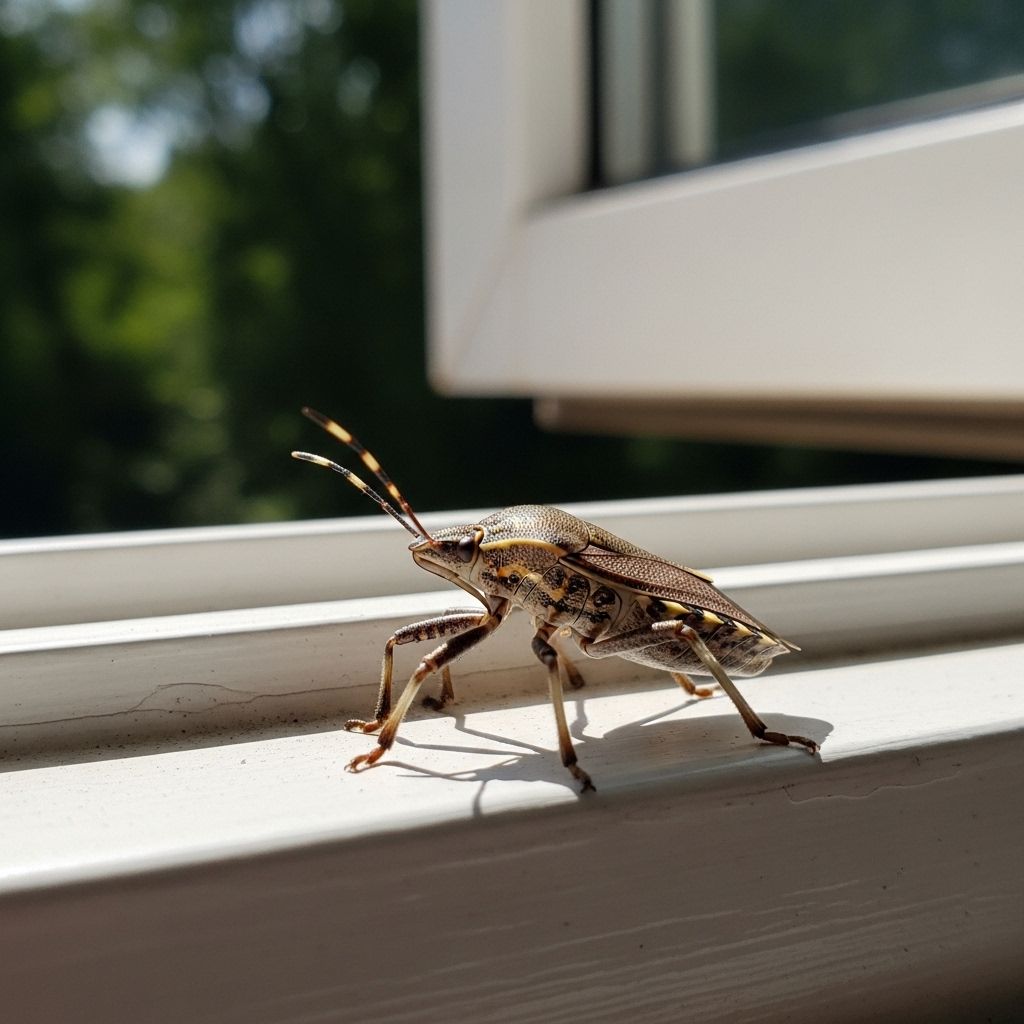Why Stink Bugs Invade Homes—and How to Keep Them Out
Invaders find fewer hiding spots once gaps are sealed and exterior lights are dimmed.

Stink bugs, easily identified by their shield-shaped bodies and infamous odor, can quickly become an unwelcome presence as temperatures dip and seasons change. Homeowners across the country notice these pests trying to breach their homes in autumn—and wonder: Why are stink bugs so attracted to my house, and what can I do about it?
What Exactly Are Stink Bugs?
Stink bugs, especially the invasive brown marmorated stink bug (Halyomorpha halys), are common agricultural and household pests. Native to Asia, they were accidentally introduced to the United States in the 1990s and have since expanded rapidly, thriving in many regions.
When threatened or handled, these bugs emit a strong, foul odor—a handy defense mechanism against predators, but not so pleasant for humans. As the weather cools in late summer and early fall, stink bugs search for warm shelter, often turning your cozy home into their safe haven for the winter.
Why Are Stink Bugs Attracted to My House?
Multiple factors draw stink bugs to residential spaces. Understanding their attraction points can help you fortify your defenses against these determined invaders.
- Warmth and Shelter: Stink bugs are cold-sensitive and need a safe spot to overwinter. Homes provide stable temperatures, making them perfect winter retreats.
- Bright Lights: Like many insects, stink bugs are drawn to exterior lighting, including porch lamps and bright outdoor fixtures.
- Food Sources: Fruit trees, produce gardens, and even crumbs or spills inside can lure stink bugs looking for sustenance before and after their dormant periods.
- Moisture: Damp basements, leaky pipes, indoor plants, and wet towels can signal a suitable environment.
- Entry Points: Cracks, gaps, and unsealed vents act as highways into your house. Once inside, they will cluster in attics, walls, and undisturbed spaces to wait out the chill.
How Do Stink Bugs Get Inside?
Their flat, flexible bodies make stink bugs especially adept at infiltrating even the smallest entry points. Typical routes include:
- Cracks in window and door frames
- Gaps around utility pipes and cables
- Unsealed vents or attic openings
- Loose siding or unprotected baseboards
- Chimneys and fireplace flues
Once a stink bug finds a suitable entry point, it will often release a chemical signal to attract more bugs, exacerbating the infestation.
Primary Attractions—Why Stink Bugs Target Your Space
- Exterior Lighting:
Stink bugs are particularly attracted to bright outdoor lights. Porch lamps, motion sensors, and even bedroom or bathroom lights visible from outside offer a beacon for these bugs at dusk and nightfall. Reducing or modifying these lights can significantly lessen the invasion risk.
In addition to managing stink bugs, implementing effective strategies to prevent ant infestations at home can create a more pest-resistant environment. Discover how simple changes can keep various pests at bay. - Untended Entry Points:
Cracks, gaps, or missing screens are key entryways for stink bugs. Once the weather turns brisk, they flock to the warmth radiating from these weaknesses. Stink bugs especially favor spots near warmth or where pipes, wires, or vents penetrate your home’s envelope.
- Nearby Vegetation:
Fruit trees, vegetable gardens, overgrown shrubs, and even unmowed lawns can draw stink bugs into your immediate environment. The closer these attractants are to the house, the more likely bugs are to wander inside.
- Food & Moisture:
Leftover produce, fallen fruit, and kitchen spills can also lure stink bugs. Indoors, standing water or high humidity can make basements, bathrooms, and laundry rooms particularly attractive.
How to Keep Stink Bugs Away: Prevention and Control Methods
If you’ve battled an invasion, you know the distinctive odor these bugs release when disturbed. Fortunately, a multi-pronged prevention strategy can help block their path, deter their interest, and manage populations that have already wandered inside.
1. Seal Up Your Home
- Inspect and repair problem areas. Check around vents, windows, door frames, utility boxes, baseboards, siding, and pipes for visible cracks or gaps. Fill small holes with caulk or foam sealant, and use weather stripping tape on actual seams.
- Secure all screens. Make sure window and vent screens are intact and fit tightly. Patch or replace torn mesh. Add screens to attic vents and chimney openings.
- Close fireplace flues. When not in use, keep the chimney flue closed to block another sneaky access point.
2. Dim or Eliminate Exterior Light
- Turn off unnecessary lights near entryways, especially during peak migration in fall.
- Use yellow “bug lights” that are less attractive to most insects than standard white bulbs.
- Shield light fixtures so minimal light escapes to the exterior.
3. Use Natural Repellents
- Essential oils such as lemongrass, spearmint, mint, and neem can repel stink bugs. Mix with water and spray around doorways, windowsills, and other likely entry points.
- Garlic spray. Create a spray by crushing garlic cloves into water, then spritz it where stink bugs might access your home. Many people find the odor a useful deterrent indoors and out.
- Herb gardens. Consider planting strong-smelling herbs like mint or rosemary in garden beds or pots near your entryways to help deter stink bugs from gathering close to the structure.
4. Eliminate Attractants Outside
- Keep the yard tidy. Trim back overgrown plants, bushes, and trees that touch the house. Remove decaying leaves, fallen fruit, or other debris regularly.
- Store firewood away from the home’s perimeter, and don’t let garden tools or plant clippings accumulate near the foundation.
5. Manage Moisture and Food Sources
- Fix leaks promptly in pipes, faucets, and drains. Ensure proper ventilation for basements, bathrooms, and other humid areas.
- Keep kitchens and pantries spotless. Clean spills quickly, store food in tightly sealed containers, and take out garbage frequently.
- Routinely check under sinks and appliances for hidden dampness.
6. Physical Removal and Indoor Control
- Vacuuming: Use a vacuum (preferably with a disposable bag) to remove bugs without crushing them, as squashing releases their notorious stink. Dispose of the bag immediately outside.
- Soapy water trap: Flick invading bugs into a container of soapy water, which suffocates and kills them quickly.
- Do-it-yourself light traps: At night, set a lamp over a tray of soapy water—the bugs are attracted by the light and fall in.
7. Professional Help
If preventive measures and home remedies don’t curb the population—or if the infestation is large—consult a professional pest control company. Experts can identify breeding or hiding spots and apply targeted, safe treatments tailored to your home.
Table: Stink Bug Attractants & Prevention Methods
| Attractant | Preventive Strategy |
|---|---|
| Bright outdoor lighting | Reduce use, switch to yellow bulbs, position lights away from doors/windows |
| Cracks and gaps | Seal with caulk or foam, install tight-fitting screens, use weatherstripping |
| Food (garden & household) | Harvest fruits/vegetables regularly, store food airtight, clean up spills |
| Moisture/leaks | Repair leaks, ventilate damp spaces, remove wet towels/rugs |
| Overgrown vegetation | Trim plants, clean up leaves, keep yard neat |
FAQs About Stink Bugs in Your Home
Q: Are stink bugs dangerous to humans or pets?
A: Stink bugs do not bite or sting, and they are not known to transmit diseases to humans or pets. They are considered nuisance pests due to their smell and potential for agricultural harm.
Q: Why do stink bugs smell so bad?
A: Stink bugs emit a foul odor as a defense mechanism when threatened or crushed—this scent can linger and is highly unpleasant indoors.
Q: Will squashing stink bugs make the problem worse?
A: Crushing stink bugs will release their odor, and may also attract more stink bugs to the area due to the alarm pheromones they emit. Instead, use gentle removal methods like vacuuming or trapping in soapy water.
Q: Can I use insecticides on stink bugs?
A: While some over-the-counter insecticides can kill stink bugs, prevention and exclusion methods are often more effective and safer. If necessary, a licensed pest control provider should handle chemical treatments, especially for severe infestations.
Q: Do stink bugs come back every year?
A: Yes, stink bugs have a seasonal migration and overwintering cycle. They often seek shelter in the same places each year unless entry points are sealed and attractants minimized.
Proactive Steps: Your Stink Bug Control Checklist
- Seal all cracks and crevices in your home’s exterior, especially before autumn.
- Replace and reinforce screens on windows, doors, and vents.
- Limit the use of bright outdoor lights, or switch to yellow insect-repellent bulbs.
- Use essential oils or natural sprays at potential entry points.
- Maintain a clean and orderly environment indoors and out.
- Quickly address leaks or standing water around the home.
- Be vigilant each fall and spring for new infestations, and act quickly if you see the bugs reappear.
When to Call the Professionals
For recurring and severe infestations, even diligent homeowners may need expert intervention. Licensed pest control professionals can:
- Conduct a thorough inspection for hidden entry points or harborage sites
- Apply targeted treatments that are safe for family and pets
- Advise on long-term prevention strategies tailored to your property and climate
Final Thoughts
Stink bugs may be persistent, but with vigilance, practical prevention, and a bit of persistence, you can keep these smelly invaders at bay. Start with sealing your home, managing lights and food sources, and employing natural deterrents. For severe or stubborn cases, don’t hesitate to consult the pros. The earlier you take action, the fresher your living space will stay—year after year.
References
- https://www.environmentalpc.com/blog/why-are-stink-bugs-attracted-to-my-house-and-how-to-get-rid-of-them
- https://thepestrangers.com/top-9-ways-to-keep-stink-bugs-away/
- https://www.prevention.com/life/a34192633/why-stink-bugs-are-attracted-to-your-house/
- https://www.canr.msu.edu/news/managing_brown_marmorated_stink_bugs_in_homes
- https://ortho.com/en-us/insect-control/how-to-get-rid-of-stink-bugs-in-your-home.html
Read full bio of Sneha Tete











